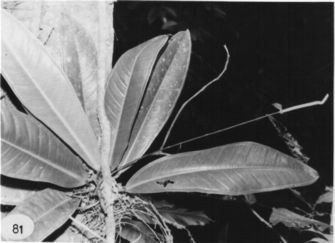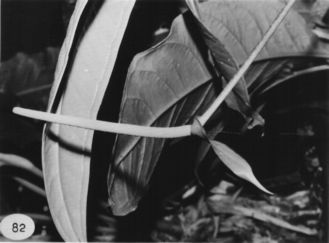





Anthurium fragrantissimum Croat, sp. nov.
TYPE: Panama. Code: new works at Rivera sawmill, Alto Calvario, 600-800 m, Folsom 3184 (MO 2603144, holotype; B, F, K, NY, PMA, SEL, US, VEN, isotypes; Live at MO).
Plerumque epiphytica; cataphyllum membranaceum, persistens in reticulum fibrarum, petiolus argute sulcatus, 3.5-19(-25) cm longus; lamina subcoriacea, oblanceolato-elliptica aut oblongo-elliptica, basi obtusa ad acuta, 28-44 cm longa, 5-10 cm lata, pagina inferiore glanduloso-punctata; inflorescentia effusa; pe-dunculus teres, 40-52 cm longus; spatha pallide viridis, oblanceolata, 6-10 cm longa, 1.5-2 cm lata; spadix pallide viridis, 10.3-12 cm longus, valde aromaticus; baccae rubrae, obovoidae ad obovoido-ellipsoideae, 6 mm longae.
Usually epiphytic; stems 7-10 cm long, ca. 4 cm diam.; roots moderately thin, descending; leaf scars and internodes obscured by persisting cata-phylls; cataphylls thin, 4.5-6 cm long, rounded and apiculate at apex (the acumen to 5 mm), drying brown (B & K- Yellow-red 3/10), persisting as reticulate fibers.
LEAVES erect to spreading; petioles 3.5-19(-25) cm long, 6-8 mm diam., sharply sulcate, rounded abaxially; geniculum 0.8-1.3 cm long, shaped like petiole; blades subcoriaceous, usually oblanceolate-elliptic, sometimes oblong-elliptic, sometimes arched along midrib, acuminate at apex, obtuse to acute at base, 28-44 cm long, 5-10 cm wide; both surfaces semiglossy, upper surface eglandular, lower surface paler, densely glandular-punctate; midrib raised and broadly rounded above, narrowing and sunken at apex, convexly raised below; primary lateral veins 20-25 per side, departing midrib at ca. 35° angle, sunken, loop-connected from base; interprimary veins slightly sunken above, obscure below; collective vein sunken above, raised below, 2-8 mm from margin.
INFLORESCENCE spreading, equal to or longer than leaves; peduncle 40-52 cm long, 3.5-4 mm diam., terete, green or purple (B & K Blue-purple 2/10), 3-4 times longer than petioles; spathe oblanceo-late, pale green, 6-10 cm long, 1.5-2 cm wide, broadest at base, inserted at ca. 70° angle on peduncle, decurrent ca. 1.2 cm on peduncle; spadix pale green (B & K Yellow-green 7/5), 10.3-12 cm long, 6-8 mm diam. near the base, 3-4 mm diam. near the apex; flowers square, 2-2.3 mm in both directions, the sides jaggedly sigmoid, the principal spiral with 4÷6(-10) flowers visible, 7-8 flowers visible in the alternate spiral; tepals matte, 1-1.4 mm wide, the inner margins straight, flat against pistil; pistils emergent, darker green than tepals; stigmas linear, with clear droplets apparent 1 month before stamens appear, drying brown before stamens emerge; strongly aromatic at this time and continuing for several days; stamens emerging rapidly in a regular sequence beginning at the base, each of the 4 stamens (beginning with one of the laterals) emerging throughout the spadix before the succeeding stamens (second lateral, anterior alternate, finally the posterior alternate) begin to emerge, held against sides of pistil; anthers bright yellow, 0.4-0.5 mm long, 0.5-0.6 mm wide; the-cae ellipsoid, slightly divaricate; pollen golden yellow, fading to white.
INFRUCTESCENCE pendent; berries red, obovoid to obovoid-ellip-soid, ca. 6 mm long, ca. 3 mm wide; pericar thick, with raphide cells; mesocarp with numerous, large, raphide cells; seeds 1 or 2, ovoid-ellipsoid, tan, scarcely flattened, 2.7 mm long, 1.5 mm wide with blunt appendage just covering beak of seed. Figs. 81 and 82.
Anthurium ftagrantissimum is known from Panama and Colombia in El Valle. It occurs from near sea level to 1,200 m (mostly above 300 m) in tropical wet and premontane rain forest life zones.
The species, a member of section Porphyrochitonium, is distinguished by its usually many-veined, oblanceolate to oblong-elliptic leaf blades that dry conspicuously blackened, its sharply sulcate petioles less than one-half as long as the blade, and by its elongate, scarcely tapered greenish to greenish white spadix that is markedly sweet scented during the middle part of the day. The species is also characterized by its red berries. It is not easily confused with any other species.
The name of the species refers to the strong, pleasant fragrance of the flowers at anthesis, which is unusual for members of section Porphyrochitonium, as most of the species of this group are not fragrant.
Anthurium fragrantissimum is repeatedly fragrant during midday for several weeks after the flowers have matured during both the pistillate phase and the staminate phase. The aroma is usually apparent by 11:00 a.m. (often as early as 9:00 a.m.), continues strong until about 2:00 p.m. and diminishes altogether usually by 4 or 5 a.m. The midday occurrence of aroma suggests that this species (and other cloud forest species as well that are known to have timely emission of aroma) has evolved an intermittent scent to attract insects only during that pan of the day when the weather usually permits the flight of insects. It is well known that during much of the year cloud forest areas are characterized by extreme fog during part of the morning and by clouds and rain in late afternoon.
 |
 |
Map of Mesoamerican specimens with coordinates
Panama Bocas del Toro: 120 m, 8.55N 82.10W, 5 March 1986, Gordon McPherson
8582A (MO).
Panama CoclŽ: 200-400 m, 8.45N 80.35W, 4 Feb. 1983, C. Hamilton &
G. Davidse 2720 (MO).
Panama CoclŽ: Rivera Sawmill,, , Folsom 3184 (AAU, CM, MBM, MEXU, MO,
OOM, RSA, SAR, W).
Panama CoclŽ: 200-400 m, 8.42.43N 80.37.15W, 3 Feb 1983, G. Davidse
& C.W. Hamilton 23489 (MO).
Panama CoclŽ: 200-400 m, 8.42.43N 80.37.15W, 3 Feb 1983, G. Davidse
& C.W. Hamilton 23587 (MO).
Panama Col—n: Río Guanche, 10-20 m,, 19 Jan 1973, Kennedy &
Foster 2204 (US).
Panama Col—n: < 100 m., 09.27N 79.40W, 19 June 1994, Thomas B. Croat
& Guanghua Zhu 76249 (CM,MO).
Panama Panamá: 450 m, 09.18N 79.59W, 3 April 1993, Thomas B. Croat
75126 (B, MO, WU).
Panama Panamá: 700-750 m, 9.15N 79.25W, 19 June 1988, Thomas B. Croat
68621 (MO).
Panama San Blas: 200-300 m, 9.20N 79.00W, 13 Feb. 1983, C. Hamilton
& H. Stockwell 2944 (MO).
Panama San Blas: 350 m, 9.19N 78.55W, 11 March 1986, Greg de Nevers,
Heraclio Herrera & Stephanie Kaza 7302 (MO)
Panama San Blas: 300-350 m, 9.15N 79W, 12 July 1988, Croat 69284 (MO).
Panama San Blas: 350 m, 09.20N 78.58O, 2 Julio 1994, C. Galdames et
al. 1248 (US).
Panama Veraguas: 570 m, 08.33N 81.08W, 13 July 1994, Thomas B. Croat
& Guanghua Zhu 76817A (MO).
Panama Veraguas: 480 m, 8.33N 81.08W, 28 June 1987, Thomas B. Croat
66941 (CM,MO).
Panama Veraguas: 570 m, 08.33N 81.08W, 13 July 1994, Thomas B. Croat
& Guanghua Zhu 76860 (MO).
Map of South American Specimens with coordinates
Colombia Choco: 150 m, 5.29N 76.35W, 16 April 1983, Thomas B. Croat
55987 (MO).
Colombia Choco: 150 m, 5.44N 76.29W, 20 April 1983, Thomas B. Croat
56219 (CHOCO, JAUM, MO).
Colombia Choco: 50 m, 5.27N 76.39W, 12 March 1984, Thomas B. Croat
57363A (CHOCO, JAUM, MO).
Colombia Choco: 130-180 m, 5.25N 76.28W, 8 Dec. 1983, Adrian Juncosa
1560 (JAUM, MO).
Colombia Choco: Serrania del Darién, 280 m, 8.30N 77.20W, 13
Jan. 1983, Adrian Juncosa 622 (JAUM, MO).
Colombia Choco:, 14 Jan. 1984, Adrian Juncosa 1921 (JAUM, MO).
Colombia Choco: < 100 m, 05.33N 76.37W, 17 Dec 1980, Croat &
Cagallo 52158 (MO).
Colombia Choco: 100 m, 5.33N 76.37W, 17 Dec. 1980, Croat & Cogollo
52161 (COL, JAUM, MO).
Colombia Choco: 200 m,, 18 Dec. 1980, Croat & Cagallo 52294 (MO).
Ecuador Napo: Yasuni, 245 m, 0.59S 76.12W, 11 Jan 1995, Milton Aulestia,
G. Oucare & B. Quihuiano 3013 (MO, QCNE).
Guyana Rupununi: 260 m, 03.07N 59.06W, 27 January 1994, Jansen-Jacobs,
M.J. et al. 3404 (MO).
Venezuela Amazonas: Depto. Casiquiare,, 3 Feb. 1991, Colella et al.
1789 (NY).
.